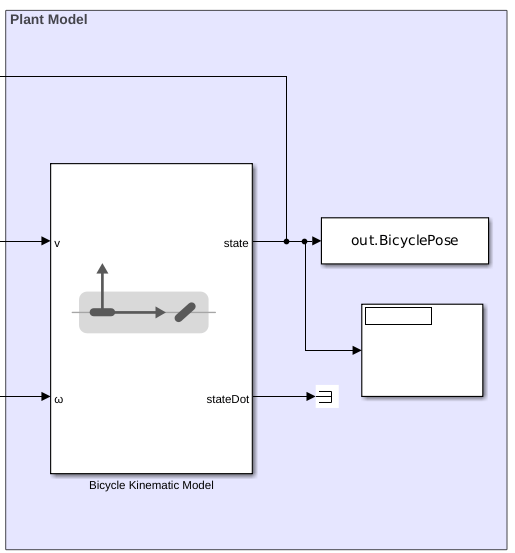Planificar una ruta para un robot de bicicleta en Simulink
Este ejemplo muestra cómo ejecutar una ruta libre de obstáculos entre dos ubicaciones de un determinado mapa en Simulink®. La ruta se genera mediante un algoritmo de planificación de rutas probabilísticas (PRM) (mobileRobotPRM)). Los controles de comando para desplazarse por esta ruta se generan utilizando el bloque de controlador Pure Pursuit. Un modelo de movimiento cinemático de bicicleta simula el movimiento del robot a partir de estos comandos.
Cargar el mapa y el modelo de Simulink
Cargue el mapa en el área de trabajo de MATLAB
load exampleMaps.matIntroduzca las ubicaciones inicial y objetivo
startLoc = [5 5]; goalLoc = [12 3];
Los mapas importados son: simpleMap, complexMap y ternaryMap.
Abra el modelo de Simulink
open_system('pathPlanningBicycleSimulinkModel.slx')Visión general del modelo
El modelo se compone de cuatro operaciones primarias:
Planificación
Control
Modelo de planta
Planificación

El bloque de función de MATLAB® Planner utiliza el planificador de rutas mobileRobotPRM y toma como entradas una ubicación inicial, una ubicación objetivo y un mapa. Los bloques generan el arreglo de waypoints que sigue el robot. Posteriormente, los waypoints planificados son usados por el bloque de controlador Pure Pursuit.
Control
Pure Pursuit

El bloque de controlador Pure Pursuit genera los comandos de velocidad lineal y angular en función de los waypoints y la pose actual del robot.
Comprobar si se alcanza el objetivo

El subsistema Check Distance to Goal calcula la distancia actual hasta el objetivo y, si se encuentra dentro de un umbral, la simulación se detiene.
Modelo de planta

El bloque Bicycle Kinematic Model crea un modelo de vehículo para simular la cinemática simplificada de un vehículo. El bloque toma velocidades lineales y angulares como entradas de comando desde el bloque de controlador Pure Pursuit y genera los estados de posición y velocidad actuales.
Ejecutar el modelo
Para simular el modelo
simulation = sim('pathPlanningBicycleSimulinkModel.slx');Visualizar el movimiento del robot
Para ver las poses:
map = binaryOccupancyMap(simpleMap)
map =
binaryOccupancyMap with properties:
mapLayer Properties
LayerName: 'binaryLayer'
DataType: 'logical'
DefaultValue: 0
GridLocationInWorld: [0 0]
GridOriginInLocal: [0 0]
LocalOriginInWorld: [0 0]
Resolution: 1
GridSize: [26 27]
XLocalLimits: [0 27]
YLocalLimits: [0 26]
XWorldLimits: [0 27]
YWorldLimits: [0 26]
robotPose = simulation.BicyclePose
robotPose = 362×3
5.0000 5.0000 0
5.0001 5.0000 -0.0002
5.0007 5.0000 -0.0012
5.0036 5.0000 -0.0062
5.0181 4.9997 -0.0313
5.0902 4.9929 -0.1569
5.4081 4.8311 -0.7849
5.5189 4.6758 -1.1170
5.5366 4.6356 -1.1930
5.5512 4.5942 -1.2684
⋮
numRobots = size(robotPose, 2) / 3; thetaIdx = 3; % Translation xyz = robotPose; xyz(:, thetaIdx) = 0; % Rotation in XYZ euler angles theta = robotPose(:,thetaIdx); thetaEuler = zeros(size(robotPose, 1), 3 * size(theta, 2)); thetaEuler(:, end) = theta; for k = 1:size(xyz, 1) show(map) hold on; % Plot Start Location plotTransforms([startLoc, 0], eul2quat([0, 0, 0])) text(startLoc(1), startLoc(2), 2, 'Start'); % Plot Goal Location plotTransforms([goalLoc, 0], eul2quat([0, 0, 0])) text(goalLoc(1), goalLoc(2), 2, 'Goal'); % Plot Robot's XY locations plot(robotPose(:, 1), robotPose(:, 2), '-b') % Plot Robot's pose as it traverses the path quat = eul2quat(thetaEuler(k, :), 'xyz'); plotTransforms(xyz(k,:), quat, 'MeshFilePath',... 'groundvehicle.stl'); pause(0.01) hold off; end
![Figure contains an axes object. The axes object with title Binary Occupancy Grid, xlabel X [meters], ylabel Y [meters] contains 16 objects of type patch, line, image, text.](planpathforabicyclerobotinsimulinkexample_05_es.png)
© Copyright 2019-2020 The MathWorks, Inc.